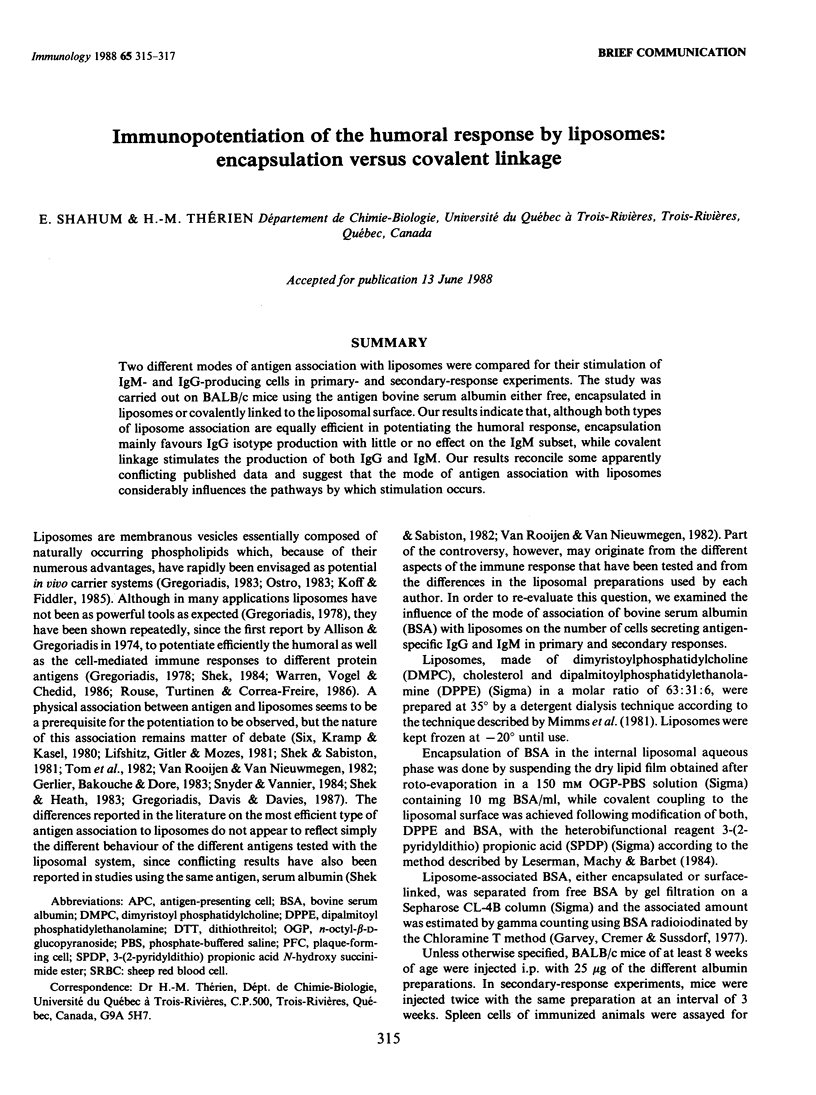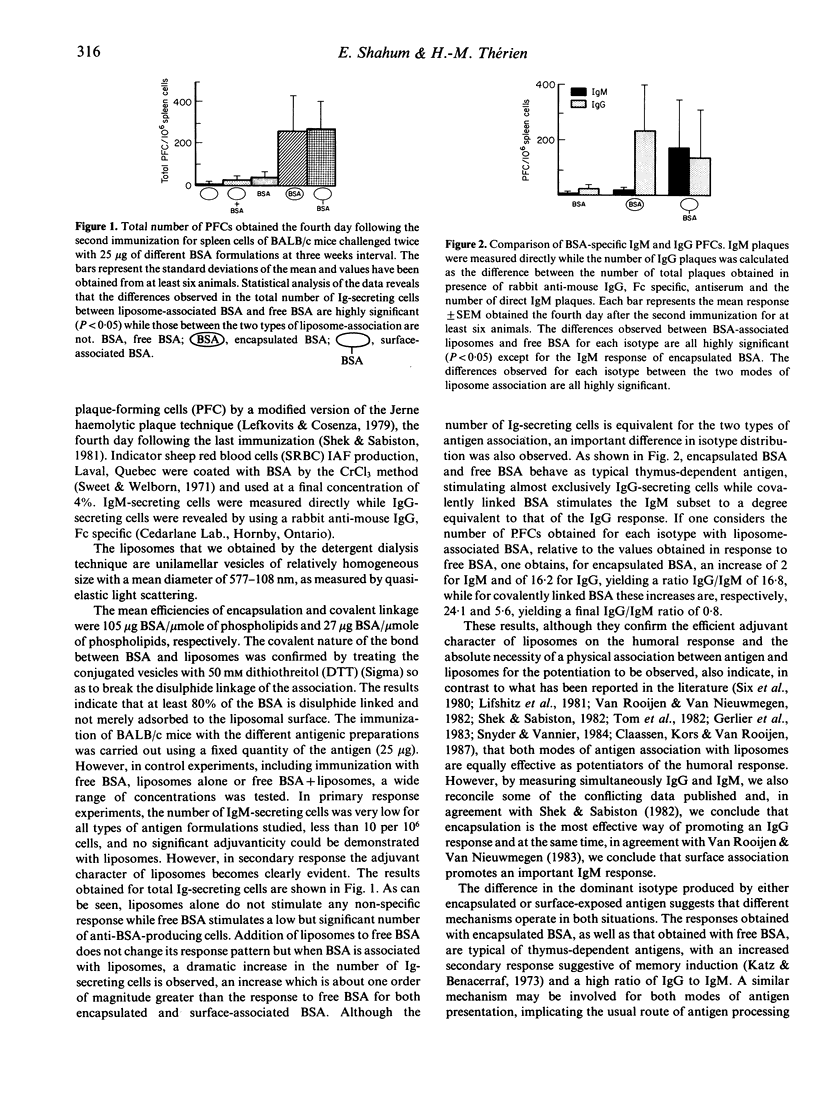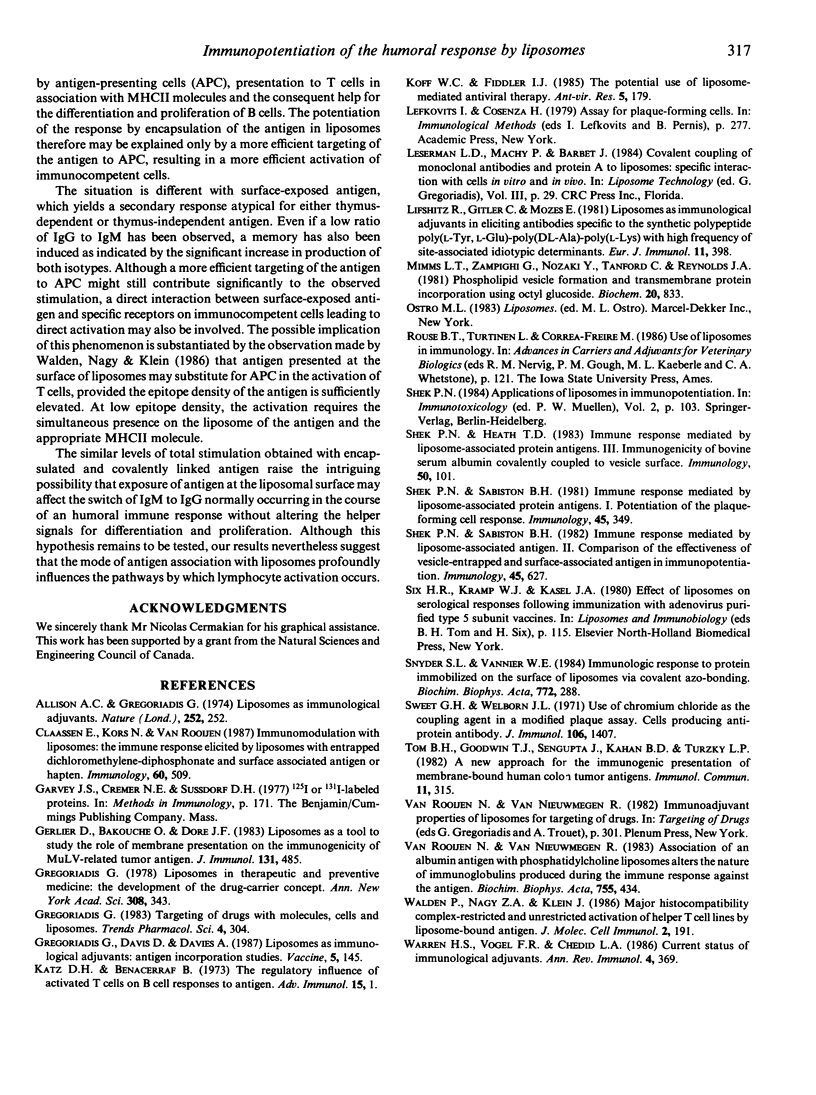Abstract
Two different modes of antigen association with liposomes were compared for their stimulation of IgM- and IgG-producing cells in primary- and secondary-response experiments. The study was carried out on BALB/c mice using the antigen bovine serum albumin either free, encapsulated in liposomes or covalently linked to the liposomal surface. Our results indicate that, although both types of liposome association are equally efficient in potentiating the humoral response, encapsulation mainly favours IgG isotype production with little or no effect on the IgM subset, while covalent linkage stimulates the production of both IgG and IgM. Our results reconcile some apparently conflicting published data and suggest that the mode of antigen association with liposomes considerably influences the pathways by which stimulation occurs.
Full text
PDF


Selected References
These references are in PubMed. This may not be the complete list of references from this article.
- Allison A. G., Gregoriadis G. Liposomes as immunological adjuvants. Nature. 1974 Nov 15;252(5480):252–252. doi: 10.1038/252252a0. [DOI] [PubMed] [Google Scholar]
- Claassen E., Kors N., van Rooijen N. Immunomodulation with liposomes: the immune response elicited by liposomes with entrapped dichloromethylene-diphosphonate and surface-associated antigen or hapten. Immunology. 1987 Apr;60(4):509–515. [PMC free article] [PubMed] [Google Scholar]
- Gerlier D., Bakouche O., Dore J. F. Liposomes as a tool to study the role of membrane presentation in the immunogenicity of a MuLV-related tumor antigen. J Immunol. 1983 Jul;131(1):485–490. [PubMed] [Google Scholar]
- Gregoriadis G., Davis D., Davies A. Liposomes as immunological adjuvants: antigen incorporation studies. Vaccine. 1987 Jun;5(2):145–151. doi: 10.1016/0264-410x(87)90063-6. [DOI] [PubMed] [Google Scholar]
- Gregoriadis G. Liposomes in therapeutic and preventive medicine: the development of the drug-carrier concept. Ann N Y Acad Sci. 1978;308:343–370. doi: 10.1111/j.1749-6632.1978.tb22034.x. [DOI] [PubMed] [Google Scholar]
- Katz D. H., Benacerraf B. The regulatory influence of activated T cells on B cell responses to antigen. Adv Immunol. 1972;15:1–94. doi: 10.1016/s0065-2776(08)60683-5. [DOI] [PubMed] [Google Scholar]
- Koff W. C., Fidler I. J. The potential use of liposome-mediated antiviral therapy. Antiviral Res. 1985 Jun;5(3):179–190. doi: 10.1016/0166-3542(85)90050-6. [DOI] [PMC free article] [PubMed] [Google Scholar]
- Lifshitz R., Gitler C., Mozes E. Liposomes as immunological adjuvants in eliciting antibodies specific to the synthetic polypeptide poly(LTyr, LGlu)-poly(DLAla)--(LLys) with high frequency of site-associated idiotypic determinants. Eur J Immunol. 1981 May;11(5):398–404. doi: 10.1002/eji.1830110510. [DOI] [PubMed] [Google Scholar]
- Mimms L. T., Zampighi G., Nozaki Y., Tanford C., Reynolds J. A. Phospholipid vesicle formation and transmembrane protein incorporation using octyl glucoside. Biochemistry. 1981 Feb 17;20(4):833–840. doi: 10.1021/bi00507a028. [DOI] [PubMed] [Google Scholar]
- Shek P. N., Heath T. D. Immune response mediated by liposome-associated protein antigens. III. Immunogenicity of bovine serum albumin covalently coupled to vesicle surface. Immunology. 1983 Sep;50(1):101–106. [PMC free article] [PubMed] [Google Scholar]
- Shek P. N., Sabiston B. H. Immune response mediated by liposome-associated protein antigens. I. Potentiation of the plaque-forming cell response. Immunology. 1982 Feb;45(2):349–356. [PMC free article] [PubMed] [Google Scholar]
- Shek P. N., Sabiston B. H. Immune response mediated by liposome-associated protein antigens. II. Comparison of the effectiveness of vesicle-entrapped and surface-associated antigen in immunopotentiation. Immunology. 1982 Dec;47(4):627–632. [PMC free article] [PubMed] [Google Scholar]
- Snyder S. L., Vannier W. E. Immunologic response to protein immobilized on the surface of liposomes via covalent azo-bonding. Biochim Biophys Acta. 1984 May 30;772(3):288–294. doi: 10.1016/0005-2736(84)90145-7. [DOI] [PubMed] [Google Scholar]
- Sweet G. H., Welborn F. L. Use of chromium chloride as the coupling agent in a modified plaque assay. Cells producing anti-protein antibody. J Immunol. 1971 May;106(5):1407–1410. [PubMed] [Google Scholar]
- Tom B. H., Goodwin T. J., Sengupta J., Kahan B. D., Rutzky L. P. A new approach for the immunogenic presentation of membrane-bound human colon tumor antigens. Immunol Commun. 1982;11(4):315–323. doi: 10.3109/08820138209050731. [DOI] [PubMed] [Google Scholar]
- Van Rooijen N., Van Nieuwmegen R. Association of an albumin antigen with phosphatidylcholine liposomes alters the nature of immunoglobulins produced during the immune response against the antigen. Biochim Biophys Acta. 1983 Feb 22;755(3):434–438. doi: 10.1016/0304-4165(83)90247-7. [DOI] [PubMed] [Google Scholar]
- Walden P., Nagy Z. A., Klein J. Major histocompatibility complex-restricted and unrestricted activation of helper T cell lines by liposome-bound antigens. J Mol Cell Immunol. 1986;2(4):191–197. [PubMed] [Google Scholar]
- Warren H. S., Vogel F. R., Chedid L. A. Current status of immunological adjuvants. Annu Rev Immunol. 1986;4:369–388. doi: 10.1146/annurev.iy.04.040186.002101. [DOI] [PubMed] [Google Scholar]


